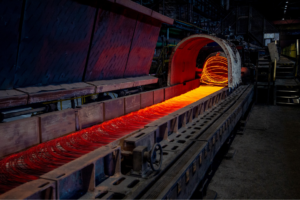
Large-scale investment projects in the chemical industry are planned in the Khorezm region of Uzbekistan, which are expected to transform this industry into one of the key drivers of economic growth in the region. This was announced by the press secretary of the President of Uzbekistan during a meeting in the Urgench district.
This year, the first phase of the construction of a $10 billion gas chemical complex will begin in the Tuprakkalinsky district, which will use MTO (methanol-olefin) technology. Upon completion of the project, the complex will annually produce 14 types of basic polymer products with high added value and a total capacity of up to 2 million tons.
The project was first announced in March last year during the Head of State’s visit to the region. At that time, Shavkat Mirziyoyev held a working meeting with the leadership of the Ministry of Energy, Uzkimyosanoat, and a large foreign investment company, whose name was not disclosed.
It was expected that the future production facilities would be able to produce up to 2.5 million tons of products per year and create about 3,000 jobs. The project is scheduled for implementation in 2024–2028.
In addition, a 10-hectare chemical technology park will be created in the Khazarasp district, where projects worth $100 million will be implemented for the production of polymer products.
Special attention was paid to the region’s construction industry. Last year, 663 enterprises in Khorezm produced building materials worth about $86.6 million. To further develop this segment, 40 new projects with a total value of $100 million are planned for implementation in 2025, which will increase production to about $118.1 million.

The Kametstal plant, part of the Metinvest mining and metallurgical group (Kamensk, Dnipropetrovsk region), has begun work on upgrading its main steelmaking equipment at one of its key facilities, converter No. 1, as part of this year’s capital repair program.
According to a press release on Monday, this year the company’s primary focus is on upgrading its power equipment, primarily the converter’s gas extraction system, where a significant portion of the equipment will be replaced with new equipment, including bellows and auxiliary caissons. The stator and rotor of the electric motor of the smoke gas blower of the gas extraction system will also be replaced.
Repairs to the converter housing have already been completed. One of the important stages of the overhaul is the complete replacement of the converter’s refractory lining. The old refractories have already been dismantled.
According to Andriy Zuev, Deputy Head of Engineering at Kametstal’s converter shop, the comprehensive tasks of all converter shop departments, as well as the Central Repair and Maintenance Department and the Central Repair Department, include not only the renovation of key equipment of the first converter, but also a thorough overhaul and repair of all infrastructure facilities of the unit: oxygen supply machines, vertical feeders for bulk materials, circulation pump units, special rolling stock – slag cars, steel cars, etc.
“Each of these facilities is undergoing mechanical, energy, and electrical repairs, which will ensure the reliable and efficient operation of converter No. 1 after the completion of the overhaul,” he said.
Kametstal is part of the Metinvest Group.

First Ukrainian International Bank (FUIB, Kyiv) received UAH 1.55 billion in net profit in January-March 2025, which is 27.2%, or UAH 0.58 billion, less than in the first quarter of 2024.
According to the bank’s financial statements, pre-tax profit in the first quarter of 2025 amounted to UAH 2.07 billion, which is 27.2%, or UAH 0.77 billion, less than in the corresponding period of 2024.
PUMB’s net interest income for the reporting period increased by 11.5%, or UAH 0.41 billion, to UAH 3.96 billion, net commission income increased by 2.9% to UAH 0.53 billion, while net income from foreign exchange operations decreased by 8.2% to UAH 0.20 billion.
At the same time, impairment losses in the first quarter of this year amounted to UAH 0.26 billion, compared with a profit of UAH 0.36 billion in the same period last year, while the bank’s operating expenses increased by 30.2% to UAH 2.4 billion.
Among other things, it is noted that in addition to software maintenance costs, which are included in operating expenses, in the first three months of 2025, the bank was provided with software development and support services by a related party in the amount of UAH 381 million, which were recognized as intangible assets, compared to UAH 190 million in the first three months of 2024.
PUBM’s total assets since the beginning of the year decreased by 3.3%, or UAH 6.16 billion, to UAH 180.43 billion, while total liabilities decreased by 4.5%, or UAH 7.36 billion, to UAH 157.0 billion.
At the same time, the bank’s equity increased by 5.1%, or UAH 1.2 billion, to UAH 23.4 billion, of which undistributed profit reached UAH 13.09 billion.
It is noted that on April 30, the shareholders’ meeting decided to allocate UAH 197.12 million of the UAH 3.94 billion net profit for 2024 to the reserve fund and leave the rest undistributed.
According to the National Bank of Ukraine, at the beginning of 2025, PUMB ranked sixth (UAH 186.5 billion) among 61 banks operating in the country in terms of total assets.

State-owned PrivatBank (Kyiv) received UAH 16.9 billion in net profit in January-March 2025, which is 21.9%, or UAH 3.0 billion, more than a year ago, when net profit amounted to UAH 13.9 billion.
The bank’s pre-tax profit amounted to UAH 22.3 billion, which is 19.1%, or UAH 3.5 billion, more than in the first quarter of 2024.
According to the report, PrivatBank’s net interest income increased by 16.4% compared to the first quarter of 2024, to UAH 18.49 billion, while net commission income increased by 4.9%, to UAH 6.64 billion.
Net income from foreign currency transactions for the reporting period increased by 11.8% to UAH 1.46 billion. In addition, the revaluation of foreign currency brought in another UAH 0.40 billion, while in the first quarter of 2024, the result was negative at UAH 0.90 billion.
At the same time, employee compensation expenses increased by 29.6% to UAH 3.64 billion, while other operating and administrative expenses increased by 11.1% to UAH 2.65 billion.
Funds in accounts of individuals in the first quarter of 2025 increased by 1.6%, or UAH 7.3 billion, to UAH 612.8 billion, while the number of individual customers decreased from 18.32 million to 18.2 million.
It is noted that PrivatBank’s net loan portfolio for January-March grew by UAH 5 billion to UAH 117.8 billion, and the number of the bank’s business clients increased from 910,000 to 918,000.
The bank reported that in the first quarter it carried out a large-scale upgrade of Privat24, including expanding accessibility for all categories of customers. As a result, the number of users grew from 13.76 million to 13.9 million.
At the same time, PrivatBank’s total assets for the first quarter of 2025 decreased by 1.1%, or UAH 8.6 billion, to UAH 752.8 billion compared to the previous quarter.
In addition, during the quarter, the number of PrivatBank branches decreased by three to 1,160, ATMs by 11 to 6,847, while terminals and POS terminals increased by 19 and more than 10 thousand to 10,439 thousand and 326.12 thousand, respectively.
According to the National Bank of Ukraine, PrivatBank ranked first in terms of total assets (UAH 947.13 billion, or 25.3%) among 61 banks at the beginning of this year.

Dnipro Switch Factory (DnSZ, Dnipro), a major Ukrainian manufacturer of switch points for main railway tracks, increased its net profit by 2.1 times in January-March 2025 compared to the same period in 2024, to UAH 113.18 million.
According to the company’s financial results report on its website, net sales revenue for this period increased by 21.7% to UAH 415.36 million.
DnSZ received UAH 135.82 million in operating profit (2.1 times more), and gross profit amounted to UAH 155.13 million (+61.2%).
Founded in 1916, DnSZ currently manufactures various types of switch points for mainline and industrial transport, subways, as well as upper track structure elements.
The company has a full production cycle, including its own design bureau.
The plant ended 2024 with a consolidated net profit of UAH 540.41 million, which is 6% more than in 2023, of which 78% (UAH 420 million) was allocated to dividend payments. Consolidated revenue increased by 77% to UAH 1.79 billion.
According to the company’s report on its website, unconsolidated net profit increased by 6.7% to UAH 544.22 million, with revenue growing by 31.1% to UAH 2.346 billion.
Exports accounted for 5.6% of total sales in 2024, with products shipped to Georgia, Azerbaijan, Moldova, Bulgaria, Germany, and the Baltic states.

The administration of US President Donald Trump is ready to pay $1,000 in compensation to illegal immigrants who decide to leave the country voluntarily, the US Department of Homeland Security said on Monday.
“Self-deportation is the best, safest, and least expensive way to leave the United States without arrest if you are in the country illegally,” the department quoted Secretary Kirstjen Nielsen as saying.
“The department is offering to pay for travel and provide a reward through the CBP Home mobile app for returning home. Every illegal immigrant who uses this app for self-deportation will receive a reward of $1,000 after confirming their return to their home country,” the press release also said.
The Associated Press notes that as part of its tougher immigration policy, the Trump administration has radically updated the app developed under former President Joe Biden. The US Customs and Border Protection (CBP) One app, which provided access to various agency services for entering the country and obtaining asylum, is now called CBP Home and is designed to “help immigrants return to their home countries,” the agency said.
In recent months, the US president has introduced a series of tough measures to combat illegal immigration. In particular, he has approved initiatives to step up the deportation of illegal immigrants from the US. Shortly after his inauguration, Trump announced the introduction of a state of emergency on the border with Mexico.